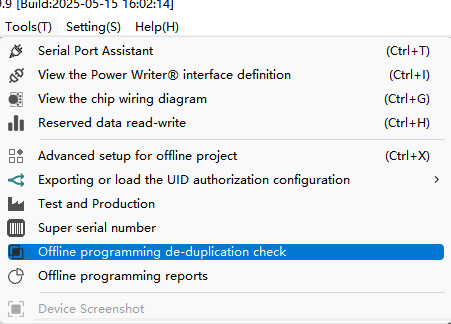5.2 Offline De-Duplication
5.2.1:Disclaimer
When de-duplication detection is turned on, repeated burning of chips that have already been burned will not consume times, super serial numbers (including standard serial numbers), signatures, etc. and other privileged assets (doesn't accumulate the number of times already burned, the remaining number of times), but rather, it will use the dynamic data that already exists in the current target chip (read back to the cache) and then combine with the current project to reburn it, but, for the reburned However, for reburning the already burned chip, the number of successful or failed burns will be totaled, and the report statistics will also be performed (if the report is on).
Due to Target chip UID, serial number (including super serial number), signature and other dynamic information, due to unpredictable reasons, including but not limited to, such as chip UID is forged, different chip serial number, signature consistent, engineering configuration information leakage situations lead to implied security issues, such as with offline burning times of burning, due to the opening of this feature, resulting in an unlimited number of times to burn! PowerWriter® will not be held responsible for any of these situations, and hereby declares that it will not be held responsible for any of these situations.
Current functionality is limited to PWX1 devices due to device performance and storage limitations.
5.2.2:Usage

The function entrance is in Menu-“Tools-”Offline Programming De-duplication Detection, after clicking this button, the function configuration page will be popped up as shown below:

Enables the offline programming chip de-duplication function: de-duplication function master switch.
De-duplication mode selection:
Based on Chip UID: If a chip UID is detected that already exists in the UID record report, it is determined to be a programmed chip.
Based on Super Serial Number or Base Serial Number: When a project has the serial number feature turned on and the serial number is within the current project configuration, it is determined to be a programmed chip.
Based on signature (Matrix only): If the signature data of the target chip is detected to be currently legal, it is determined to be a chip that has been programmed.
UID or super-serial number (file only) Search range:
tipWhen using UID mode, in addition to the chip needs to include UID function, in addition to limit the data retrieval range, to avoid performance problems in the programming process, in addition, based on the Super Serial Number file mode, you can enable the sorting function in the Super Serial Number Configuration interface to optimize the retrieval speed, for details, please refer to the About the Sorting of Super Serial Number.
- All records (may result in slower programming): start searching from the 1st record when the project was first programmed.
- Last cached 1000 records: find only from the latest 1000 records.
- Last 100 records cached: find only from the latest 100 records.
- Last 10 records cached: lookup only from the last 10 records.
When a duplicate chip is detected:
- Reprogramming (Default): This mode is the default mode, when reprogramming, the chip's dynamic data, including signature, serial number, etc. remain unchanged, rewrite the firmware data, no deduction and number of times statistics (but will update the report record).
- Return Successful: generally applicable to confirm the current batch of successfully programmed chips, quickly carry out mixing detection, and check whether the successfully programmed chips contain space (Note: the check empty function and the check function can also achieve similar effects, but faster efficiency can be achieved through this function, suitable for high-volume scenarios).
- Return Failure: Similar to Return Success, the difference is that return failures can be quickly sorted by automated equipment for subsequent analysis.
If the corresponding function is not enabled in the current project engineering configuration, the function is invalid even if the current configuration is turned on.
- When the chip has no ID, UID-based de-duplication will not be enabled.
- When the serial number function is not enabled, the function of de-duplication based on the serial number function will be disabled. In addition, when the super serial number and standard serial number are enabled at the same time, the priority is to choose the super serial number de-duplication.
- Signature-based de-duplication only supports Matrix signatures, not ICWKEY.